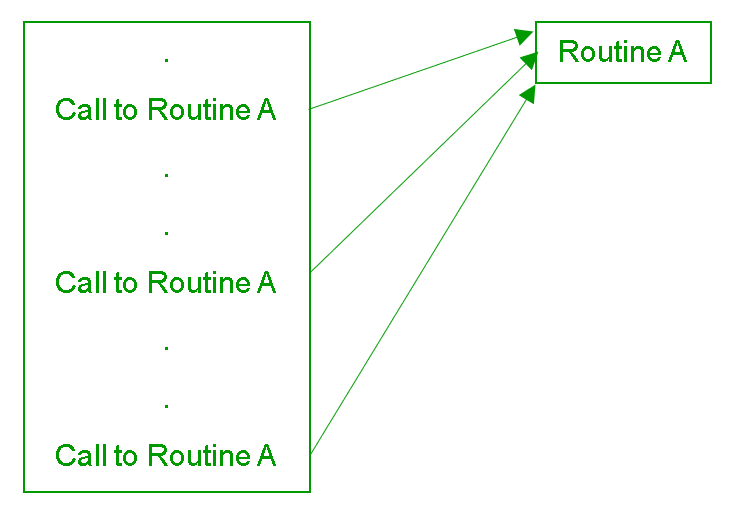What Do You Use To Separate Arguments In A Function?
A Routine is a named group of instructions performing some tasks. A routine tin always be invoked as well every bit chosen multiple times equally required in a given program.

When the routine stops, the execution immediately returns to the stage from which the routine was chosen. Such routines may be predefined in the programming linguistic communication or designed or implemented by the programmer. A Function is the Python version of the routine in a program. Some functions are designed to return values, while others are designed for other purposes.
We laissez passer arguments in a office, nosotros can laissez passer no arguments at all, single arguments or multiple arguments to a function and tin call the function multiple times.
Example:
Python
def displayMessage():
print ( "Geeks for Geeks" )
displayMessage()
Output:
Geeks for Geeks
In the higher up programme, the displayMessage() function is called without passing any arguments to it.
Python
def displayMessage(msg):
print ( "Hello " + msg + " !" )
msg = "R2J"
displayMessage(msg)
Output:
Hello R2J !
In the higher up program, the displayMessage() function is chosen by passing an argument to it. A formal statement is an argument that is present in the part definition. An bodily statement is an statement, which is present in the function call.
Passing multiple arguments to a function in Python:
- We tin can pass multiple arguments to a python function by predetermining the formal parameters in the function definition.
Python
def displayMessage(argument1, argument2, argument3):
print (argument1 + " " + argument2 + " " + argument3)
displayMessage( "Geeks" , "4" , "Geeks" )
- Output:
Geeks 4 Geeks
- In the above programme, multiple arguments are passed to the displayMessage() function in which the number of arguments to be passed was stock-still.
- We tin can pass multiple arguments to a python office without predetermining the formal parameters using the below syntax:
def functionName(*statement)
- The * symbol is used to pass a variable number of arguments to a part. Typically, this syntax is used to avert the lawmaking failing when nosotros don't know how many arguments will be sent to the office.
Python
def calculateTotalSum( * arguments):
totalSum = 0
for number in arguments:
totalSum + = number
print (totalSum)
calculateTotalSum( 5 , 4 , iii , 2 , ane )
- Output:
15
- In the to a higher place program, the variable number of arguments are passed to the displayMessage() part in which the number of arguments to be passed is not predetermined. (This syntax is only used to pass non-keyword arguments to the function.)
- Nosotros can pass multiple keyword arguments to a python office without predetermining the formal parameters using the below syntax:
def functionName(**argument)
- The ** symbol is used before an argument to pass a keyword argument dictionary to a part, this syntax used to successfully run the code when we don't know how many keyword arguments will exist sent to the function.
Python
def displayArgument( * * arguments):
for arg in arguments.items():
print (arg)
displayArgument(argument1 = "Geeks" , argument2 = 4 ,
argument3 = "Geeks" )
- Output:
('argument2', 4) ('argument3', 'Geeks') ('argument1', 'Geeks') - In the higher up program, variable number of keyword arguments are passed to the displayArgument() function.
Here is a plan to illustrate all the above cases to pass multiple arguments in a function.
Python
def displayArguments(argument1, * argument2, * * argument3):
impress (argument1)
for arg in argument2:
print (arg)
for arg in argument3.items():
print (arg)
arg1 = "Welcome"
arg3 = "Geeks"
displayArguments(arg1, "to" , arg3, agr4 = four ,
arg5 = "Geeks !" )
Output:
Welcome to Geeks ('agr4', four) ('arg5', 'Geeks!') The above program illustrates the use of the variable number of both non-keyword arguments and keyword arguments every bit well as a not-asterisk statement in a office. The not-asterisk argument is always used before the single asterisk argument and the single asterisk argument is always used earlier the double-asterisk argument in a function definition.
What Do You Use To Separate Arguments In A Function?,
Source: https://www.geeksforgeeks.org/how-to-pass-multiple-arguments-to-function/
Posted by: myersmarder.blogspot.com


0 Response to "What Do You Use To Separate Arguments In A Function?"
Post a Comment